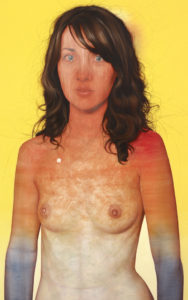
Artist Jenny Morgan has always had a talent for painting the human figure. In the early days of her career, Morgan painted hyper-realistic canvases that looked almost like photos. But as she began to evolve as an artist, a desire built to leave realism and move toward abstraction.
She wanted to peel away years of traditional training and reveal a new facet of her ability.
“It was a process of pulling back and leaving areas open and allowing myself to [manipulate] paint in a way that made me uncomfortable,” she says. “It was really about pushing my own personal boundaries and how I perceived how a painting should look like.
“Especially as a young student, you receive validation for a certain way of working,” she continues. “So, leaving those comfort zones is where I found excitement in the work.”
One day, during what she calls a “happy accident,” Morgan took a sandpaper and turpentine-dipped rag and began to rub away at the layers of oil paint she had built up.
“I had a very raw inclination to destroy the perfection, destroy the realism,” Morgan says. “To kind of take that away and go beyond it.”
It was in this destruction of her work that Morgan began to find her voice as an artist. Showing through Aug. 27 at MCA Denver, Skindeep traces the evolution of Morgan’s work over the past decade.
Throughout the years she’s embraced a variety of techniques to go beyond realism. She continues to rub away coats of the painting, leaving behind ghost-like body parts or faces peering out from behind a cloudy screen.
Her paintings are full of color, which Morgan says she uses as an emotional language. Many figures are placed amid a colorful backdrop that give energy and vibrancy to the paintings. She also uses a color glaze on top of body parts -— a glowing red fingertip or a blue arm. Some figures are even painted in non-skin tones entirely.
But while Morgan experiments with her style, she continues to use the human form as an anchor to reality.

“I think there’s a root drive in the work, understanding that I’m attracted to the correct structure, and not really distorting anything with the body, but using color or subtle abstraction on top of that to really distort it,” she says. “I know that I want to work with the figure and kind of this basic structure, and anything I do on top of that is satisfying in the work and that’s what feels like I’m pushing and developing.”
Her work has been described as portraiture, but any of her canvases show there is more at play than just a recreation. By altering the realism of the figure, Morgan paints an almost unseen realism of the psyche. Her paintings convey personifications of emotions. By rubbing away the top layers of the paint, it’s as if Morgan removes the outer persona to show what’s underneath.
Morgan sees this in her own work. She says by altering her figures, they become completely differently entities.
“The more realistic and more photographic the paintings are, for me, the more they feel like actualized people,” she says. “So, the more that I can abstract or push them in some way, they become more than a person in a spiritual way.”
When choosing her models, Morgan looks for personal connection. She’s used friends, family members and teachers. She selects people organically, looking for relationships she wants to explore.
She paints from photographs she takes during sessions with her models. Morgan prefers her models to pose nude. Removing protective layers of clothing reveals vulnerability that Morgan captures in her work.
She favors stoic poses, allowing for slight expression from the body. While she says the photo shoots can be filled with laughter, Morgan asks her models not to smile. What’s left is in-between moments that allow for open interpretation; in one painting, a figure could seem frightened, grief-stricken or even serene.
“I usually take between 50 to 100 shots. I’m still always amazed at the subtlety that can happen between the clicks of the camera lens, even when someone is not trying to be emotive,” she says. “I feel like I don’t need someone to smile or to frown or to feign crying in order to express emotion. There are much more subtle layers that can be expressed when someone is very static.”

Morgan shies away from narratives, painting her subjects in spaces devoid of context. Avoiding literal representations of specific emotions, Morgan relies on emotional impulses for her painting choices.
“At any moment in making a painting you can be partially aware of internal motivation,” she says. “But part of the magic in it is the unconscious stuff that comes through and peaks back at you.”
Along with painting her models, Morgan spends a lot of time doing self-portraits. She says they allow her to experiment deeper, and they serve as a way to process what’s going on internally.
“That’s kind of the most challenging part of doing the self-portraits,” she says. “It’s laced with looking at yourself and being challenged by yourself. … It’s about confronting myself on a consistent basis.”
Morgan uses painting as a tool for self-exploration, an approach that has allowed her to face deep-rooted fears. For her self-portrait “Helpful Spectre,” Morgan had the idea to swap black and white, seemingly turning herself inside out. The result is a painting resembling a photographic negative.
“I had nightmares of making this demonized, inverted portrait,” she says. “I worried there would be real life implications of doing that to myself. So, I had to get courage to do that.”
Looking back a year later, Morgan says it was helpful to go through that process of overcoming those fears.
“Now seeing that painting and not having that same psychological resonance for me validates that you can work through those perceived levels of fear of the unknown and come out the other side of it,” she says.
While Morgan acknowledges the cathartic nature of her self-portraits, she is hesitant to overanalyze their meaning.
“Painting and externalizing emotions visually and using a metaphorical language to get out those feelings that don’t have words attached to them is part of the process,” she says. “It’s hard for me to rewind and attach a lot of words to it. But that’s where the exhilaration comes from in the work and the personal growth comes in when I can challenge myself on those levels.”
Since Morgan’s work is rooted in visceral emotion, it’s easy for the viewer to connect with it. And with no clear narrative, the paintings can mean different things to different people. In “Mentor” a woman’s thighs glow red, which can signify lust or danger. In “Shadow Play” a blue hand reaches around Morgan’s head, begging the question, does it represent a deeper part of the psyche coming to the surface, or is it a foreign element completely?
And Morgan’s heard many different theories.
“One person came up to me at an opening and said that he sees all of the detached hands in my work as male. That’s how he’s seeing something alien touching the female body -— that [element] becomes male to him,” she says. “And that was fascinating to me and I had to take that in and digest it, and I asked myself, ‘Are they?’
“I really do appreciate that,” she continues. “And that’s the point of making the work and sharing it with the world. Seeing how people react to it. And allowing them to project whatever they need to project on top of that.”
Blending realism and abstraction creates a third form, another dimension, a place viewers must actively search for to find what lies beneath the surface.
“It’s almost ironic,” Morgan says with a laugh. “[The work is] not skin-deep, it’s the opposite of that. But it’s also, because of the realism, easy to be confronted with these people on a surface level, and it requires a bit of time and space and a willingness to go deeper into the frame.”














